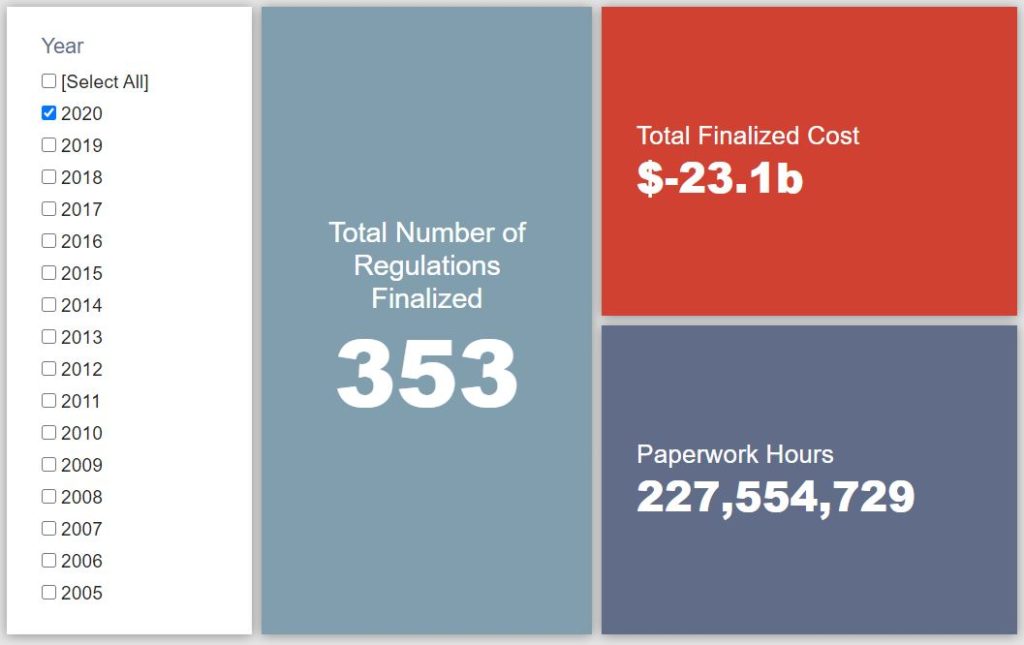Week in Regulation
November 9, 2020
November Starts Off on a Net-Regulatory Foot
The country’s focus was justifiably on the outcome of the election last week, but there was also a fair amount activity in the pages of the Federal Register. There were 20 rulemakings with some quantified cost or savings estimate. Notable topics included: immigration, opioids, and – as covered below – crop pesticides. Across all rulemakings, agencies published $543 million in total net costs and added 2 million hours of annual paperwork.
REGULATORY TOPLINES
- Proposed Rules: 54
- Final Rules: 70
- 2020 Total Pages: 71,136
- 2020 Final Rule Costs: -$23.1 billion
- 2020 Proposed Rule Costs: $17.4 billion
TRACKING THE REGULATORY BUDGET
While the top-lines of the week across both proposed and final rules came out to be, on net, cost-increasing, the most consequential action with regards to the fiscal year (FY) 2021 regulatory budget was a deregulatory measure from the Environmental Protection Agency (EPA). The EPA rule regarding the “Tolerance Crop Grouping Program V” amends the regulatory code on standards for pesticides used on herb and spice crops. Specifically, the agency notes, “Crop grouping saves money by permitting the results of pesticide residue studies for some crops, called representative crops, to be applied to other, similar crops in the group.” EPA estimates these savings to be roughly $51.8 million annually, or $740 million in present value when extrapolated out for Executive Order 13,771 purposes.
While the administration’s FY 2021 regulatory budget caps are still forthcoming, so far this fiscal year agencies have officially published 26 deregulatory actions and 5 regulatory actions, totaling $1.1 billion in quantified total net costs. The American Action Forum’s review of the administration’s FY 2020 regulatory budget progress can be found here.
THIS WEEK’S REGULATORY PICTURE
This week, the Department of Health and Human Services (HHS) proposes to sunset most of its regulations.

Source: https://www.federalregister.gov/documents/2021/10/29/2021-23472/securing-updated-and-necessary-statutory-evaluations-timely-proposal-to-withdraw-or-repeal
In the November 4 edition of the Federal Register, HHS proposed a rule that would require the department and its agencies to review most of their regulations within 10 years. If such a review on a regulation does not occur over that time, the regulation would sunset, or expire.
The proposed rule, “Securing Updated and Necessary Statutory Evaluations Timely,” if finalized, would mark the first time a federal agency would add expiration dates to most of its regulations, essentially forcing the agency to conduct a review of each regulation to see if it is still needed or should be modified. More information on the nuts and bolts of how the rule would work, and why HHS believes it is necessary, can be found here.
But the fate of this proposed rule will inevitably be affected by the transition from a Trump Administration to a Biden Administration, so it is worth looking at how the situation could play out.
In the first scenario, the Trump Administration HHS fails to publish a final rule in the Federal Register by noon Eastern Standard Time on January 20, 2021. Almost immediately, the Biden Administration would issue a memorandum to acting agency heads pausing all final rule submissions to the Federal Register, as well as pulling back all final rules that in the queue to be published. The Biden Administration would then likely withdraw the sunsetting proposed rule, killing it.
In a second scenario, the Trump Administration HHS publishes a final rule before January 20, 2021, making it official. The Biden Administration would have to commence a rulemaking to propose repealing the sunsetting rule and build a public record that factually supports its repeal. This process would take time but would likely prevent the sunsetting rule from ever being implemented. Once possible shortcut to this process would be if HHS is sued over the Trump Administration’s rule. A Biden Administration would be unlikely to defend it and would probably reach a settlement with the plaintiff that includes an agreement to repeal the rule.
TOTAL BURDENS
Since January 1, the federal government has published $5.7 billion in total net cost savings (with $23.1 billion from finalized rules) and 285 million hours of net annual paperwork burden increases (with 227.6 million hours due to final rules). Click here for the latest Reg Rodeo findings.












